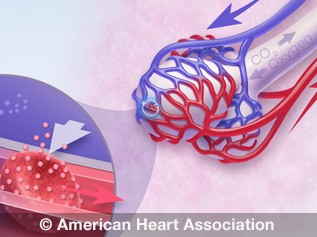
Heart Failure in Children and Adolescents
A small percentage of newborns has a structural heart problem
The heart is a pump. It’s divided into a right and left side, each with an upper and lower section. The upper section, called an atrium, receives blood from the body and pumps it through a one-way valve into the lower section, called a ventricle. These valves prevent the backward flow of blood inside the heart. The right side of the heart receives the oxygen-poor blood from the body and pumps it to the lungs where oxygen is added.

This oxygen-rich blood leaves the lungs and enters the left side of the heart. It’s then pumped into the aorta, which distributes it throughout the body to provide oxygen and nutrients for growth and normal body functions. As the body removes oxygen, the now oxygen-poor blood returns to the right side of the heart and the cycle continues.
A wall, called a septum, separates the two sides of the heart. In this way, there is no mixing of the oxygen-rich and oxygen-poor blood. The heart muscle receives oxygen-rich blood from special blood vessels called the coronary arteries. The pumping function of the heart is controlled by an internal electrical system, much like a battery and internal wires.
Watch an animation of blood flow in the heart.
What is heart failure?
For a child to grow and develop, the heart needs to maintain normal pump function, to provide optimal blood flow throughout the body. However, sometimes the heart of a child may not function normally. The term “heart failure” describes a heart that’s not functioning properly. It does not mean that the heart has stopped working, but instead that it isn’t working as well as it should.
Heart failure occurs in adults due to effects of smoking, high blood pressure, diabetes, coronary artery disease and bad heart valves. It can occur in newborns, infants, toddlers and teenagers for other reasons. Since heart failure has different causes and outcomes, it’s important to recognize how it’s diagnosed, treated and even cured in younger children.
There are two primary causes of heart failure in children and adolescents. The first, “over-circulation failure,” occurs when blood mixes inside the heart due to a congenital heart defect. The second, “pump failure,” occurs when the heart muscle becomes damaged and no longer contracts normally.
What causes heart failure in children?
Over-circulation failure
About 1 percent of all newborn infants will have some type of structural heart defect. In some of these defects, there are holes between the heart’s right and left chambers. Because of these holes, the oxygen-poor and oxygen-rich bloods mix inside the heart. A defect of blood vessels in the head or other parts of the body (AV malformation) can cause similar mixing of the oxygen-poor and oxygen-rich blood but outside the heart.
Abnormal heart valves can also cause heart failure. An abnormally formed valve that does not close properly causes blood to leak backwards. Rarely, a strep throat infection can result in damage to otherwise normal heart valves, causing them to leak as well.
Finally, low blood (anemia) can also result in heart failure. These defects lead to over-circulation failure. In each instance, an overload blood flow pattern occurs in one or more of the sections of the heart. The normal forward blood flow is interrupted, and the heart becomes an inefficient pump.
Pump failure
Like hearts in adults, a child’s heart may also develop pump failure. This can be caused by a virus infection that damages otherwise normal heart muscle. Or, pump failure can arise from problems with the coronary arteries, preventing effective blood flow to the heart muscle itself. Such issues with the coronary arteries can occur from birth or be the result of infection.
Certain drugs, some necessary to treat other medical problems (like cancer or leukemia) can also damage the heart muscle. The heart’s electrical system also may be abnormal from birth or damaged by infection, causing the heart to beat too slow or too fast. Sometimes one of the heart valves does not open properly, causing pressure to back up inside the heart chambers.
Rarely, severe chest trauma may damage the heart. Children with muscular dystrophy may eventually also develop problems with their heart muscle.
In each situation, the heart muscle fails to function normally, and the heart becomes an inefficient pump.

Possible symptoms in children with heart failure:
- Trouble breathing
- Poor feeding or growth
- Excessive sweating
- Low blood pressure
How is heart failure identified?
In infants, heart failure often presents with breathing trouble, poor feeding, poor growth, excessive sweating or even low blood pressure. At times, heart failure can look like other problems such as colic, pneumonia or other respiratory infections. Often parents may note that an infant takes longer to feed or becomes uninterested in feeding after a short time. If heart failure is caused by too rapid a heartbeat, parents may feel the rapid heartbeat through the chest wall when the infant is sleeping or resting quietly.
Older children and teenagers may complain of becoming tired quickly, especially if a virus infection has caused heart muscle damage.
If your physician suspects that your child may be experiencing heart failure symptoms, a chest X-ray may help determine if the heart is enlarged. You also may be referred to a pediatric heart specialist – such as a pediatric or congenital heart cardiologist – for further evaluation and testing.
Additional tests can include an electrocardiogram (EKG or ECG) to evaluate the heart rhythm or an ultrasound of the heart (echocardiogram) to evaluate heart structure and function. Both tests are simple and are typically performed in the physician’s office or clinic. Neither test is painful. However, depending on your child’s age and ability to cooperate, light sedation may be necessary for the best test results.
Sometimes, older children (usually older than 4) may be asked to perform an exercise stress test to evaluate heart-lung function.
At times, a more detailed and invasive test called a heart catheterization study may be required. In this test, a small plastic tube (called a catheter) is placed inside the heart from a blood vessel in the leg or arm. The catheter is used to record pressures and the amount of oxygen in the different parts of the heart. Commonly, a small amount of an X-ray dye (or contrast) material is injected to make a movie of the heart function and coronary arteries. The child usually receives deep sedation to ensure the best results. Since this test is performed in a special catheterization procedure room or laboratory, a short admission to a hospital is often necessary.
How is heart failure treated?
If heart failure is caused by over-circulation due to a congenital heart defect, surgery is often necessary to repair the defect. Often, your physician may initially treat your child with medications, which sometimes requires hospitalization. The medications may include diuretics (water pills) and afterload reducers. They can help unload the excessive volume, lower blood pressure resistance and allow the heart’s pump function to improve.
Since over-circulation causes poor growth, your physician may consider nutritional supplements to ensure that your child is receiving enough calories to compensate for the increased energy requirements. Other dietary changes such as low-salt and low-fat diets may be discussed. Following appropriate treatment, your child’s condition and symptoms may improve. This is called compensated heart failure.
However, the underlying cause may persist. If heart surgery is required, you will have the opportunity to discuss the types of surgery or other treatments that are available.
If the heart failure is caused by pump failure, the same medications listed above may be used. Sometimes other medications that lower blood pressure help the heart pump better. Hospitalization may be necessary to further improve heart function. At times, surgery may also be required, such as replacing a damaged heart valve.
Pump failure caused by a heartbeat that’s too slow often requires a pacemaker. Pacemakers remind the heart to maintain a normal heart rate. The small, battery-operated devices are like tiny computers and are implanted under your child’s skin with a small wire connected to the heart. This requires a surgical procedure.
If the pump failure is caused by a heartbeat that’s too fast, your child may require medications to control the heartbeat. At other times, a specialized heart catheterization procedure called radiofrequency ablation may be recommended to correct the abnormal heart rhythm. This procedure applies short bursts of radio waves to the area of heart muscle causing the rapid heartbeat.
Rarely, if pump failure is caused by irreversible muscle damage, heart function may not improve with medication but may continue to get worse. In this situation, a special pacemaker, mechanical pump (LVAD) or ECMO (extracorporeal membrane oxygenator) may be necessary to improve heart pump function temporarily. If heart muscle function continues to deteriorate despite therapy, your heart specialist may discuss the need for a heart transplant.
Room for optimism
Although heart failure can happen to any child, it’s not necessarily a hopeless condition. Many of the causes can be repaired. It’s important that parents and family members understand the causes and treatments of heart failure in children.
When parents ensure that proper medical care is provided – and as newer techniques and medications become available – most children with heart failure should be able to grow and lead active lives.






